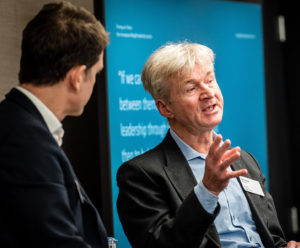Q&A: Why creativity and distinctiveness fuel long-term brand growth – in conversation with Peter Field
Sean Kearns
“What does a brand do for us? Without a brand, you are dead.”
 Peter Field is one of the world’s leading experts on brand marketing and measurement. He believes that in the era short-termism, an increasing number of B2B businesses are neglecting the long-term value of the brand.
Peter Field is one of the world’s leading experts on brand marketing and measurement. He believes that in the era short-termism, an increasing number of B2B businesses are neglecting the long-term value of the brand.
To coincide with the release of the Thought Leadership Network’s Proving Our Value report, Peter reveals why creativity and distinctiveness are at the heart of effective thought leadership – and long-term brand growth.
How are B2B brands responding to the challenge of balancing short-term activation and brand-building?
B2B businesses are probably more susceptible to the pressures of short-termism that the world of marketing has been subjected to during the past 10 years of the big data era. That line of thinking is very seductive, but it’s also lethally dangerous. If it’s all about short-term data-led acquisition marketing, then you walk away from brand marketing and you essentially restrain growth, and this is what has been happening. A lot of B2B businesses are very sales led, and I think they have increasingly doubted the value of the brand.
How are businesses trying to overcome short-termism?
You have to have brand metrics in place that are going to correlate with long-term growth. But this is a huge area of conjecture. A lot of work is being done on ‘mental availability’, which is the extent to which a brand comes easily to mind in a buying situation. The businesses I have worked with, and are doing good things, are those that have realised they have to develop a brand identity – a brand entity that can work through the funnel and not just at the top. It’s not just about notoriety, fame, getting talked about; it’s also about supporting the sale of products as you move down the line.
How can CMOs achieve a balance between long-term brand investment and short-term targets?
The smart marketers I work with have a really clear understanding about the difference between long-term growth drivers and short-term sales activators, and they understand they have to do both, and that these two kinds of approaches are radically different. If you really want to be agile in the sense of being able to turn sales on in a hurry, respond to threats and take advantage of opportunities, it helps to have a powerful brand behind you. Strong, powerful brands that command respect and have all of these positive associations and are able to turn on sales in a hurry when they need to. It’s not rocket science.
Do you think creativity has been a victim of short-termism?
At an event in Sweden a year ago, it was said that creativity has no value in the modern business world, and it’s all about data and short-term objectives. That is untrue. There are still pressures on the value of creativity, but there is a magnitude of improvement in the effectiveness you can get if you have an innovative, thought-leading, creative approach in your marketing. Highly innovative marketing gets people talking about your brand.
It’s a big driver of long-term growth because of the reinforcement value. But if you’re going to spend money and effort on great creative ideas, use them for the long-term – not just to try to drive short-term sales.
Do you think the degree of control that consumers have over the buying process has been overstated?
We know from Daniel Kahneman’s work that we are all strongly influenced by heuristics – these feelings-based prejudices we develop towards brands, which have an incredibly powerful influence on decision-making. That’s the whole value of brand marketing. We can look at the impact of emotional-style marketing and see in the data that it’s massively more effective than the communication of information of rational product-based messages, which tend to only work in the short-term and in a very limited way.
What role can thought leadership specifically play in helping brands to cut through the noise?
There’s a difference between distinctiveness and differentiation in the language of marketing. Differentiation tends to be around product features and benefits. Distinctiveness tends to be about these associations and the extent to which you’re making waves and being the thought leader in that category. You need to be clear about that, but the way to really drive long-term growth is not through differentiation. It’s through distinctiveness, and distinctiveness is a very different thing. It’s absolutely rooted in thought leadership.
Speak to the team
We’ll help you to navigate and overcome any challenges you currently face and learn how to get more out of your content.
Book a meeting
About the author: Sean Kearns
In his role as strategy and innovation director, Sean is responsible for spearheading the growth, quality and relevance of FT Longitude’s products and services. The underlying goal is always the same: to increase the value to clients and their most important audiences. Sean also leads our strategy division, ensuring that every campaign is guided by intelligent planning and creative clarity.
As well as being former editorial director and editor-in-chief at FT Longitude, Sean has 20 years’ experience of creating strategic content across a range of sectors and senior editorial roles.
 |
Tel:
+44 (0)20 7873 4770
|
Tel:
+44 (0)20 7873 4770


